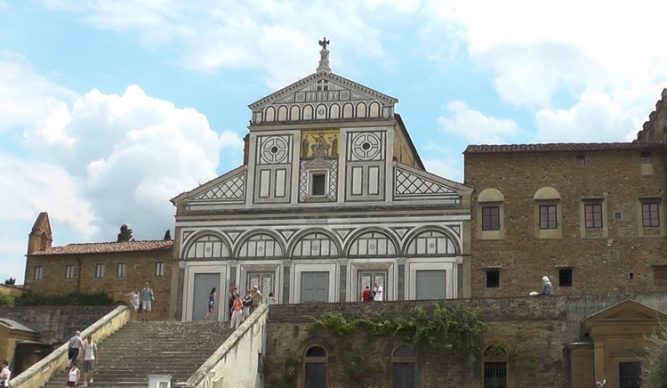San Miniato al Monte’s June Millennium Program

Perched on the city’s highest hilltop in Florence, Basilica di San Miniato al Monte, turns 1,000 this year. Even from the base of the dramatic stone steps, the golden mosaic crowning the church’s façade peeks out and shimmers in the sun as it has for centuries, evoking a dreamlike effect. The otherworldly quality of the city’s loftiest landmark will soften in a series of special celebrations this week, with commissioned music, workshops, and cultural events (all free except on June 21) to honor its millennium milestone.
The square in front of San Miniato al Monte will host all-day festivities on June 23. The day opens at 6 am, the Benedictine monks of San Miniato will perform their habitual Gregorian chant for the public. Workshops will be given in front of the adjoining monastery on medieval knowledge and crafts in addition to street shows, an offering of traditional dishes, and entertainment for children and adults. Two bands, the “Bronnoysund Music Korp” and the “Toscana Junior Band” will play at 4:15 and 9 pm respectively.
Florence’s L’Homme Armé, an organization dedicated to injecting lifeblood into Renaissance music and fusing it with the contemporary, will present “Vocal Architectures” on June 26 at 9 pm, showcasing an award-winning vocal ensemble. This concert marries Dufay’s incredibly influential renaissance music with David Lang’s Pulitzer-winning The little match girl passion, a contemporary polyphonic opera mirroring the Passion of Christ.
More original music will be featured on June 30 at the Fantasia Millenaria at 9 pm in the Basilica, where Felipe Landi performs a piano concerto with the Cupiditas Orchestra. Landi composed the piece specifically to commemorate San Miniato’s 10 centuries standing atop Monte alle Croci.
Further musical touches to the June revelry include the “Millennium Sunset Prayer Concert,” on the June 21, featuring the world premiere of original music by Ian Cecil Scott and theatrical collaboration featuring the actors of the Medici Dynasty Show who will bring to life some of San Miniato’s rich history. Organized by Associazione Passignano, with the evening’s expenses funded by Palazzo Tornabuoni, proceeds from the €35 ticket will be used by the monks to commission a sculpture to mark the anniversary, the first new work of art to grace the grounds in 150 years.
VISITING SAN MINIATO
Before setting foot in the church (free of charge), it is already easy to understand why it has been treasured and preserved for so long. This feeling is bound to grow into awe as one takes in the timeless beauty of every surface and corner of the church up close, each holding a visual wonder of its own. The more one learns and sees of San Miniato, the more it demands attention.
Basilica di San Miniato takes its name from the martyr St. Minias buried beneath it, a 3rd century Armenian who lived as a hermit near Florence, prosecuted for his Christian faith by the Roman emperor Decius. “This is the gate of Heaven” is inscribed in Latin above the church’s Holy Door, and one can see how truly fitting these words are upon entering and glimpsing the equally beautiful and welcoming interior.
The smooth walls, adorned with uncomplicated patterns, come alive as sunlight slants in through the windows. Every surface seems to be home to an architectural or artistic wonder of some sort. Classical-style capitals can be seen in the supporting columns of the church, taken from the remains of Roman buildings. One of the particularly striking floor panels contains every sign of the zodiac entwined in elaborate lace-like vines, creepers, and foliage — all etched in stone.
Works by some of the most famous Florentine artists of the late Middle Ages and the Renaissance can be found amidst the church’s plentiful adornments. Especially dazzling are the golden, Byzantine-style mosaics in the presbytery. The frescoes on the crypt’s vaulted ceilings were painted by Taddeo Gaddi, a follower of Giotto. Other remarkable frescoes include Michelozzo’s recently restored Chapel of the Crucifix, and traces of Paolo Uccello’s scenes of monastic life, which exhibit a groundbreaking use of perspective, a Florentine invention during the Renaissance.
The Chapel of the Cardinal of Portugal, added in 1473, is especially vibrant. It houses the tomb of Cardinal Iacopo of Lisbon, who fell ill and died while visiting San Miniato in 1459. Constructed in the Renaissance style, blue and white ceramics by Luca della Robbia adorn the ceiling, standing out against a backdrop of eye-popping yellow and green geometric patterning.
Though the Florence skyline, from Brunelleschi’s imposing dome to Santa Croce’s spire, is fully visible from the church’s steps, San Miniato is free from the crowds of the historical center, standing apart from the selfie-crazed chaos of Piazza Michelangelo down the street. The church’s grounds are a tourist-free oasis floating above Florence, peace and solemnity prevailing as one walks through the cemetery or sits at a pew inside, looking up at the intricate ceiling.
The adjoining monastery, founded in 1018 by Hildebrand, Bishop of Florence, is still active. Work, contemplation, and prayer remain ever vital to the Benedictine monks, whose lives hum on behind the basilica’s façade of white and green Tuscan marble and the monastery’s plain brown walls. It is the most recognizable feature of this jewel of Romanesque architecture, sometimes even referred to as “Proto-Renaissance.” The quietly stunning façade makes it easy for awestruck onlookers to miss the sweeping view of the city just behind them. (tyler bunton)
